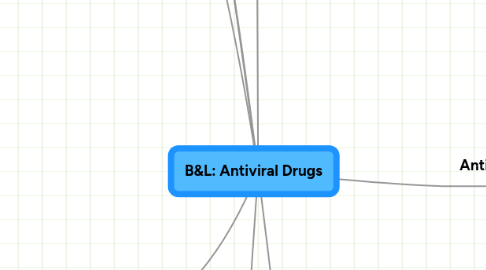
1. SE
1.1. BMD
1.2. Flu-like Sx
1.3. CNS: depression and suicidal behavior
2. NNRTs ("non-nukes")
2.1. MOA
2.1.1. Bind directly to HIV-RT
2.2. PK
2.2.1. Both undergo hepatic metabolism (CYP3A4)
2.2.1.1. Potent CYP3A4 inducers!
2.2.1.1.1. MAJOR D-D interaxns!!!
2.3. Efavirenz
2.3.1. Advantages
2.3.1.1. Potent antiviral activity
2.3.1.2. Low pill burden
2.3.2. SE
2.3.2.1. Neuropsychiatric (dl)
2.3.2.2. Teratogenic
2.3.3. PK
2.3.3.1. Metabolized by p450 - mixed inducer/inhibitor
2.4. Nevirapine
2.4.1. Advantage
2.4.1.1. Safe for pregnancy
2.4.2. SE
2.4.2.1. Rash, including rare hypersensitivity rxn
2.4.2.2. Hepatitis
2.4.3. PK
2.4.3.1. Metabolized by p450 - 3A inducer
3. Eliminated by hepatic metab (CYP3A4)
3.1. D-D interaxn potential
4. Serious HSV and CMV infections
5. Herpes viruses: HSV, zoster, CMV
5.1. Most drugs are nucleoside analogs (metabolite is TP)
5.1.1. TP competitively inhibs viral DNA polymerase
5.1.2. Express highly selective toxicity
5.1.2.1. Initial conversion occurs via VIRAL kinase
5.2. Acyclovir
5.2.1. MOA
5.2.1.1. acyclic guanosine analogs
5.2.1.1.1. Phosphorylated by viral thymidine kinase
5.2.2. Use
5.2.2.1. HSV-1, HSV-2, VZV
5.2.2.2. HSV encephalitis (type I herpes)
5.2.2.3. DOC: serious HSV infections!!!
5.2.2.4. Famici-/valacyclovir: oral forms used to Tx genital herpes and shingles
5.2.3. Side effects
5.2.3.1. Well tolerated po
5.2.3.2. IV
5.2.3.2.1. Acute renal failure
5.2.3.2.2. Nuerotox
5.3. Ganciclovir
5.3.1. MOA
5.3.1.1. Acyclic guanoside analog
5.3.2. Use
5.3.2.1. Prv and Tx of CMV
5.3.2.2. Prv of CMV reactivation in transplant pts
5.3.3. Side effects
5.3.3.1. Greater tox than Acy- d/t less selectivity
5.3.3.2. BMD
5.3.3.2.1. Additive effect with AZT
5.3.3.3. CNS: Headache, behavioral changes, convulsions, coma
5.4. Foscarnet
5.4.1. MOA
5.4.1.1. NOT a nucleoside analog (i.e. does not require activation by kinases
5.4.1.2. Pyrophosphate analog
5.4.1.2.1. Blocks pyrophos binding site & inhib cleavage of pyrophos from dNTPs
5.4.2. Use
5.4.3. SE
5.4.3.1. Renal insufficiency
5.4.3.2. Hyopcalcemia
5.4.3.3. Cardiac arrythmias d/t electrolyte imbalance
5.4.4. PK
5.4.4.1. IV only
5.4.4.2. Must titrate dose to Cr clearance
6. Resp. Virus Infections
6.1. Neuraminidase inhibitors
6.1.1. Zanamivir & Oseltamivir
6.1.1.1. Use
6.1.1.1.1. Influenza A & B
6.1.1.2. Effective against Avain and Swine flu (Flu A H5N1 and H1N1, resp)
6.1.1.3. Zanamivir
6.1.1.3.1. PK
6.1.1.3.2. Use
6.1.1.3.3. SE
6.1.1.4. Osetlamivir
6.1.1.4.1. PK
6.1.1.4.2. Use
6.1.1.4.3. SE
6.2. Viral uncoating inhibitors: Amantadine & Rimantadine
6.2.1. Use
6.2.1.1. Influenza A
6.2.1.2. Not effective against Avian and Swine flu
6.2.1.3. Pre-exposure prophylaxis
6.2.1.3.1. Like in a nursing home epidemic
6.2.2. MOA
6.2.2.1. Prevents uncoating of viral RNA
6.2.2.1.1. Inhib viral proton channel M2
6.2.3. PK
6.2.3.1. Amantadine crosses BBB!!!
6.2.3.1.1. Used in Parkinsonism
6.2.3.2. GI
6.2.3.2.1. nausea, anorexia
6.2.3.2.2. nervousness, ADD, insomnia
6.2.4. SE
6.2.4.1. CNS
6.2.4.2. Worse with Amantadine
6.3. Resp. Syncytial Virus (RSV): Ribavirin
6.3.1. MOA
6.3.1.1. Competitive inhibitors of Flu A&B neuraminidases
6.3.1.1.1. Prevents the release of progeny from the host cell
6.3.2. Use
6.3.2.1. Severe RSV in infants and kids
6.3.2.2. Hep C
6.3.2.2.1. In combo w/ IF-alpha
6.3.3. MOA
6.3.3.1. Guanosine analog
6.3.4. SE
6.3.4.1. Inhalation: reversible decline in pulm fn
6.3.4.2. Oral: Anemia
6.3.5. Teratogenic!!!
7. Hepatic Virus Infections
7.1. Ribavirin
7.2. Interferon-alpha
7.2.1. MOA
7.2.1.1. Turns on gene expression of proteins w/ antiviral effects
7.2.2. Use
7.2.2.1. Hep B (in combo w/ Ribavirin)
7.2.2.2. Hep C
7.3. Nucleoside analogs
7.3.1. Lamivudine
7.3.2. Entecavir
8. Anti-HIV
8.1. Always used in combination Tx!!!
8.1.1. Triple combo = 2 nukes + 1 other class
8.1.2. Need to prevent resistance
8.1.3. Compliance is a major issue
8.2. Nucleoside analogs ("nukes")
8.2.1. MOA:
8.2.1.1. Triphophate inhibits HIV reverse transcriptase
8.2.1.1.1. selective for virus
8.2.1.2. Also causes chain termination
8.2.2. Side effects
8.2.2.1. Lactic acidosis
8.2.2.2. Hepatic steatosis
8.2.3. PK
8.2.3.1. Good bioavailability
8.2.3.2. Renally cleared (mostly)
8.2.4. Lamivudine
8.2.5. Zidovudine (AZT)
8.2.5.1. SE
8.2.5.1.1. BMD
8.2.5.1.2. anemia
8.2.5.1.3. neutropenia
8.2.5.2. Good for pregnancy
8.2.5.2.1. Single dose at birth used to reduce MTCT
8.2.6. Stavudine
8.2.7. Didanosine
8.3. Protease Inhibitors
8.3.1. MOA
8.3.1.1. Competative inhibition of viral protease
8.3.1.1.1. Sits in the virus's active site
8.3.1.2. Prevents immature virions from becoming mature, infections viruses
8.3.2. PK
8.3.3. Good for pregnancy
8.3.4. SE
8.3.4.1. At low dose (50mg) just inhib CYP3A4 to improve bioavailability of other PI in combo
8.3.4.2. GI - NVD
8.3.4.3. Hepatotox
8.3.4.4. Metabolic
8.3.4.4.1. Body fat redistribution
8.3.4.4.2. Hyperlipidemia
8.3.4.4.3. Insulin resistance
8.3.5. Ritonavir
8.3.5.1. use
8.3.5.1.1. Mostly used for PI boosting
8.3.6. Indinavir
8.3.7. Amprenavir
8.3.8. Nelfinavir
8.3.9. Saquinavir
8.4. Fusion inhibitor
8.4.1. Enfuvirtude
8.5. Entry inhibitor: CCR5 co-receptor antag
8.5.1. Maraviroc
8.6. Integrase inhib
8.6.1. Raltegravir
